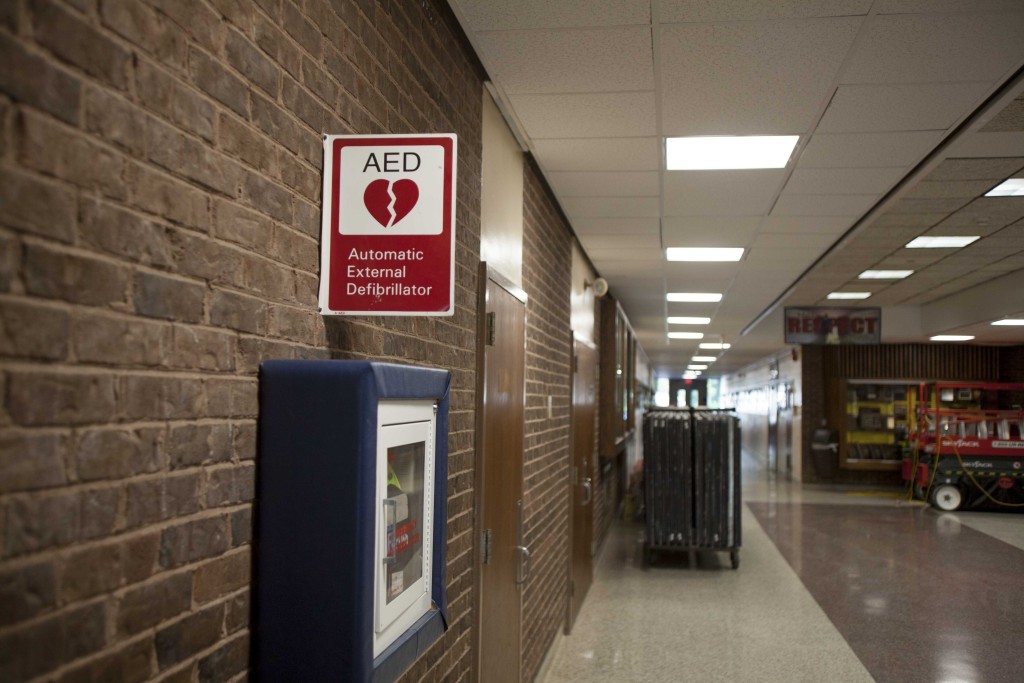Community pushes Shoreham-Wading River to purchase more AED machines

A moment after the gunshot-like crack of the bat, he was dead.
On May 9, the 15-year-old Shoreham-Wading River student technically died while playing baseball in Rocky Point. His heart stopped when a line drive hit him in the chest. It was the worst nightmare for parents, players, coaches and everyone involved: On a Little League field meant for fun and celebration, a young life was on the verge of slipping away.
Then, an onlooker at the scene revived the player with an AED machine and tragedy was avoided.
Now, inspired by that success, members of the Shoreham Wading-River community are pushing the district to go above and beyond state requirements by purchasing more AED machines and upping regulations.
Dr. Marc Dinowitz, a Wading River surgeon, and Karen Acompora, a part-time Wading River resident who founded the Acompora Foundation after her son died from a lacrosse-induced chest injury 15 years ago, are leading a charge that Dr. Dinowitz describes as protecting “student safety.”
“What we’ve noticed is that even though the devices are technically there on [school] grounds, they’re not always with the coach or the referees or the people running the games outside,” Dr. Dinowitz said.
The two worked with athletic director Mark Passamonte to recommend the district add more than 30 machines, an investment of $40,000 to $60,000. Their chief concern is that existing machines are not accessible quickly enough in case of an emergency.
“This should be our first priority,” Dr. Dinowitz told the Board of Education at its meeting last Tuesday. “We’re behind the times.”
Ms. Acompora said all machines should be reachable within two minutes — a standard that is not currently met in all areas of the district, Mr. Passamonte said during the meeting.
“Schools have AEDs,” Ms. Acompora said. “However, they don’t have good emergency action plans … Sometimes they don’t even bring them outside to the fields.”
Currently, Mr. Passamonte explained, the district has 15 machines across all of its buildings: seven at the high school/district office or with the athletic trainer, three at the middle school, two at each elementary school and one at the Briarcliff building.
The existing machines cost about $3,000 per year for inspections, and any replacement parts are charged on top of that — though Dr. Dinowitz said batteries can last “years.” If the district were to add 30 machines as recommended, the yearly maintenance could triple.
District leaders are in the process of considering the push, and the school board will hear an assessment from an AED expert at the July 28 meeting.
Addressing financial concerns will be the biggest challenge, however.
Board members at last week’s meeting said they consider machines an important investment, but first they need to find funding. Due to regulations, that funding must be reallocated specifically from the equipment code.
“We have to find the money,” board president John Zukowski said. “The budget was passed, and we need to create the space to come up with the money.”
For supporters, the cost is far worth the potential.
“It’s not a big expenditure if you’re going to save someone’s life,” Ms. Acompora said. “If they can’t do all 30 AEDs, let’s start. We’ve offered to donate and there’s creative ways of funding it.”
Dr. Dinowitz and Ms. Acompora also submitted a formal “time-out” proposal to Section XI, which governs all public school athletics in Suffolk County.
Under Dr. Dinowitz’s idea, school-sanctioned athletic events would be forbidden from commencing until coaches announce where AED devices are located and who is qualified to use them.
“Only after that is done, basically assuring that the devices are ready to be used, should the games be played,” he said. “It’s a pretty simple concept and it really doesn’t cost anything.”
Dr. Dinowitz hopes Shoreham-Wading River will “spearhead” the plan and be the first district to enact such policies.
Don Webster, executive director of Section XI, said the organization’s safety committee would consider the proposal at its next meeting this fall, likely in late September or early October.
After that, it would go through the athletic directors and district superintendents, so Mr. Webster said it’s unlikely anything would be instituted before November.
Mr. Webster said the proposal has mixed chances. The component that requires coaches to list the nearest AED machine is “relatively easy” since it consists of information that could be attached to existing sportsmanship statements.
However, he was cautious when commenting on whether the organization could realistically mandate schools to add enough machines to be present at every event.
“State rule is that they have to be readily available for the person that needs to use it in any emergency,” he said. “It doesn’t say there has to be one at every single site. That would have a lot more implications from a budgetary standpoint and a logistical standpoint.”
Photo: An AED station at Shoreham-Wading River High School. (Credit: Chris Lisinski)







